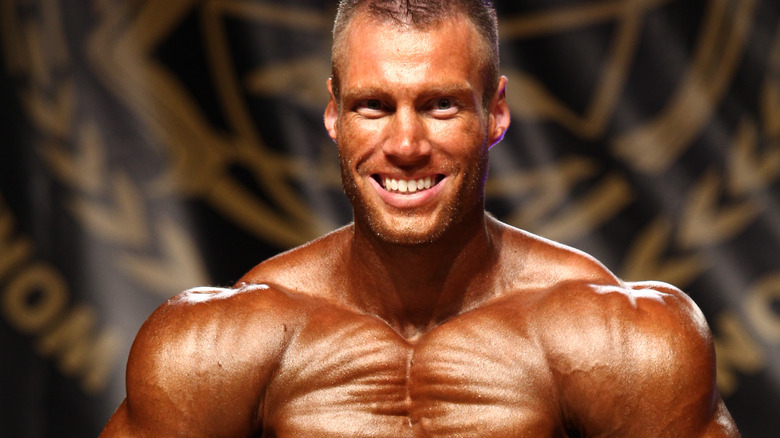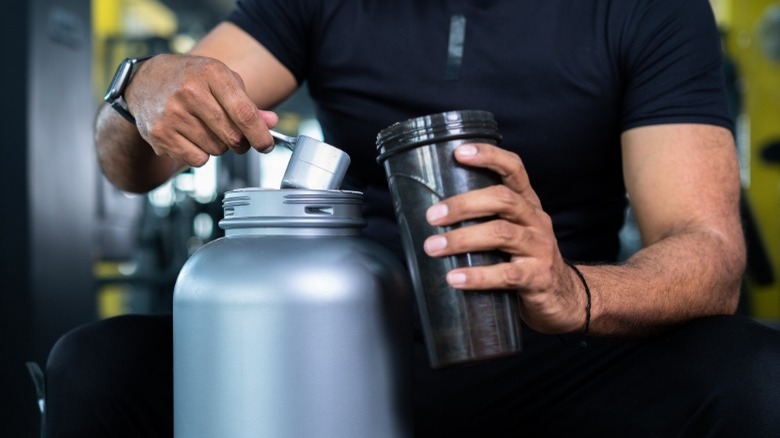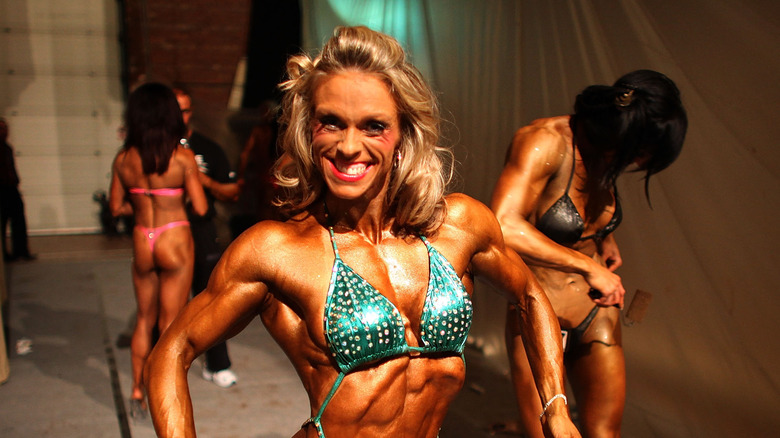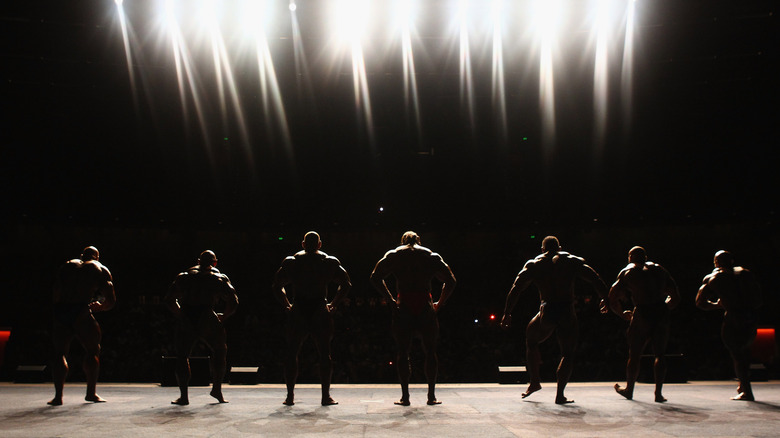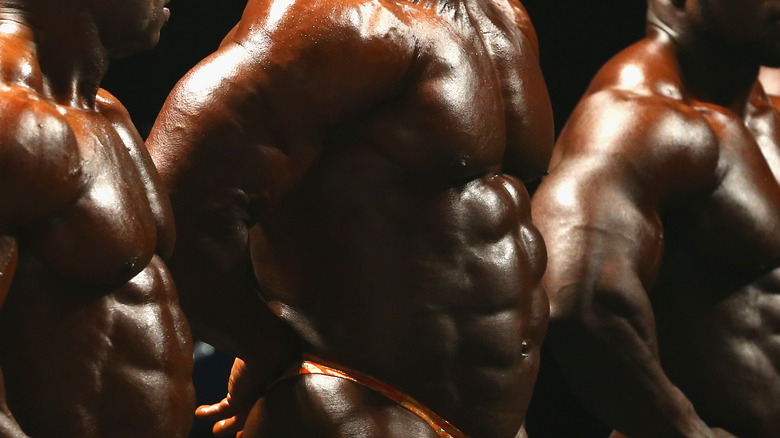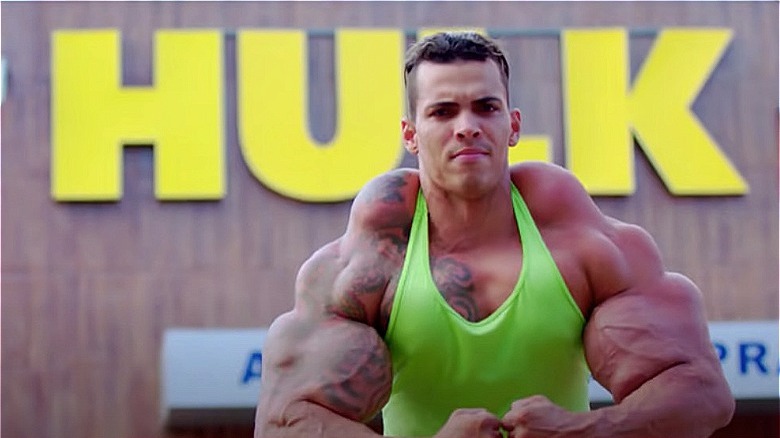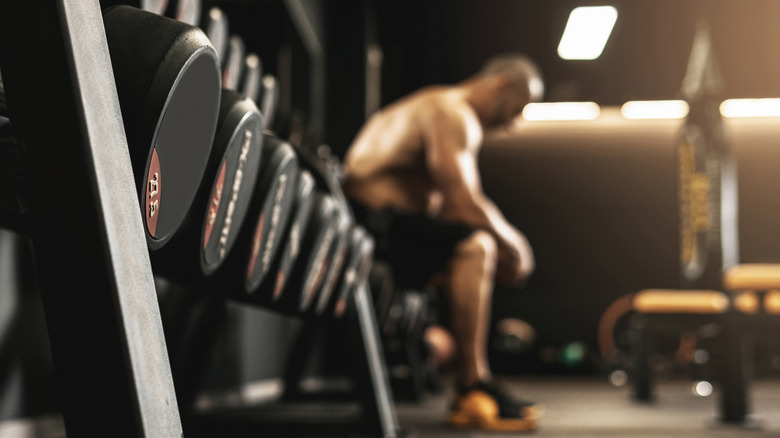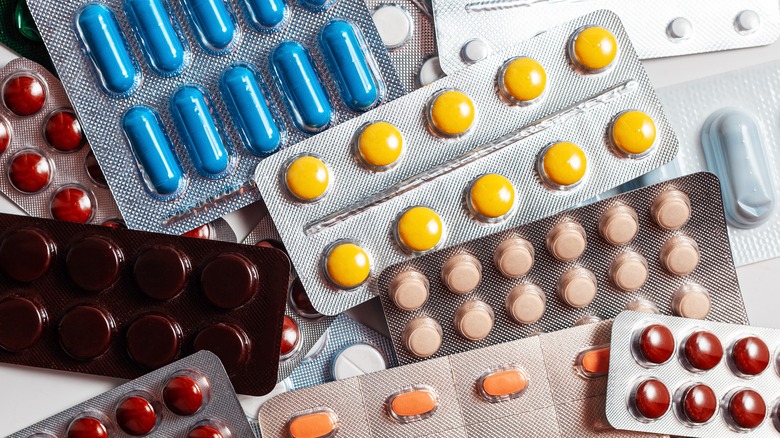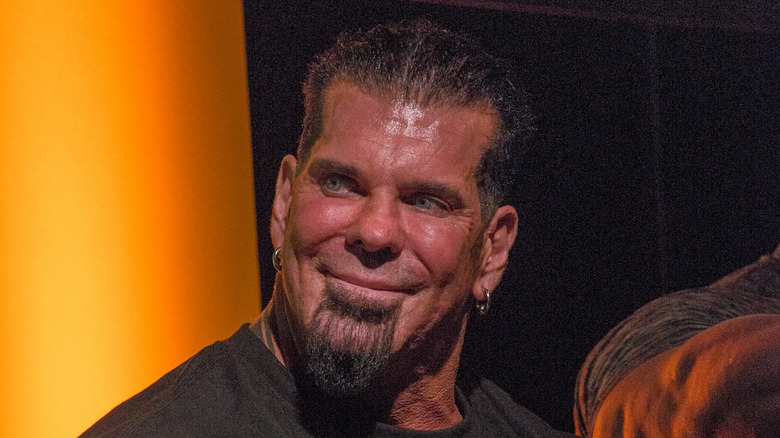The Dark Side Of Bodybuilding
For most people, a bodybuilding regimen is wholly positive. A routine of weight training, cardio, and balanced nutrition will yield many health benefits, including stronger muscles, greater stamina, and healthier bones and joints (via Bodybuilding). It will also help control body weight and decrease the chances of heart disease, high cholesterol, and numerous other maladies. Perhaps bodybuilding's most gratifying benefit is its release of endorphins in the brain, which can help to reduce stress, anxiety, and depression.
However, bodybuilding is not always a healthy, balanced sport. Both amateur and professional bodybuilders push their bodies to extremes, and may use cocktails of drugs — namely steroids — to achieve their goals. These drugs can create a litany of health issues such as heart disease, liver failure, and infertility, among many others (via the Mayo Clinic).
There are psychological consequences, too. Competitive bodybuilding requires an obsessive dedication to regimen and routine, sometimes at the expense of friends and family. It can also be hard for bodybuilders to establish a fixed limit on their goals. Some will get lost in the rabbit hole of muscle dysmorphia, a mental disorder that convinces bodybuilders that they are never big enough. So, without discounting its many benefits, here is the dark side of bodybuilding.
The following article contains references to addiction, abuse, and mental health struggles. If you or anyone you know is experiencing these issues, help is available. Contact SAMHSA's National Helpline at 1-800-662-HELP (4357).
The supplement industry
YouTube bodybuilder Scooby1961 has spent over a decade calling out the supplement industry, which he accuses of peddling toxic products that are dishonest about the reality of gaining muscle and losing fat. "People buy these ridiculous diet plans ... and all they get is weaker and fatter," Scooby told his subscribers, "they are simply unwilling to accept that there are no shortcuts."
Numerous other YouTubers have excoriated the supplement industry, too. For example, Jeff Nippard discussed "the five worst supplements everyone takes for muscle growth," which were testosterone boosters, turkesterone, BCAAs, fat burners, and beta-alanine. Nippard explained that these products had, "a severe lack of scientific evidence for muscle growth or fat loss." Rich Piana also cut through the marketing noise, "Real food is the secret. Real food is the best possible thing you can put in your body ... 12 egg whites, two cups of oatmeal, there's nothing better for breakfast than that."
Such criticisms have done little to dent the supplement industry, which, according to Fortune Business Insights, is forecast to grow from a value of $129.60 billion in 2021, to $196.56 billion by 2028.
Stigmatization of female bodybuilding
According to Dr. Tanya Bunsell, female bodybuilders are often labeled "grotesque," "fake," "freak," "narcissistic," "pornographic," and "scary." A 17-year-old bodybuilder told her, "People can be so cruel. I've had people shout out their car window at me 'are you a geezer?', or stop me out in the street when I'm shopping and ask me 'are you a man or a woman?'"
Bunsell, who frequented gyms and worked backstage at competitions, investigated why women pursue bodybuilding. Many told her that they began lifting to control how they look and feel, often after childbirth, rehab, alcoholism, and eating disorders. The gym became a sanctuary for many of these women.
Regrettably, some women may never find the sanctuary of the weight room, since they report feeling "overwhelmed" or "intimidated" by the often male-dominated spaces (via Insider). "Gym anxiety is so common," said powerlifting coach Lis Saunders, "...even though I have lots of lifting and coaching experience now, I still feel anxious every time I go to the gym."
Biased judging
Mr. Olympia is the most prestigious competition in bodybuilding and has been held annually since 1965 (via Barbend). Despite its longevity, Mr. Olympia received mainstream broadcasting just once — back in 1980. As competitor Boyer Coe remembered, a CBS film crew covered the event in Sydney, but decided it couldn't broadcast the material because of the show's controversial winner: Arnold Schwarzenegger.
Schwarzenegger had won the tournament six times and retired from the sport by 1975. Since then, he starred in "Pumping Iron" and "Stay Hungry," two early stepping stones in his Hollywood career. Few thought that he would come back to competitive bodybuilding, but he did just that on the very day of the competition in October 1980, having trained for just eight weeks.
After rubbing numerous competitors the wrong way, Arnold took to the stage and won the trophy, despite showing noticeably less muscle mass than he had at earlier Olympias. "A lot of people believe that politics in bodybuilding were the reason why Arnold won," Nick Miller explained, "he was a promotor of the show, he was close to all the judges, he was close to everybody in bodybuilding." The CBS crew was among the dubious observers. "It was obvious to him that Arnold didn't deserve to win," Boyer Coe said of a CBS crewmember, "and they didn't want to put something so controversial that even the average person sitting in the audience would think 'something's wrong here.'" It has been decades since that controversy, but skepticism toward bodybuilding judges continues. Prominent YouTuber Tomn8er described IFBB judging as a "stupidly opaque system."
Palumboism
Also known as bubble gut, HGH bloat, and various other names, Palumboism refers to the phenomenon of distended, bulbous bellies amongst advanced professional bodybuilders (via Healthline). The condition is named after Dave Palumbo, who was one of the first bodybuilders to develop a gut that had bloated out of proportion. "No one knows exactly what that is," said six-time Mr. Olympia Dorian Yates, "but I started using insulin as an anabolic in '96 – '97 and my stomach started to get a bit distended, so I think this is the cause." According to Healthline, bodybuilders take insulin because it helps muscles to absorb protein and other nutrients.
As described by BabbleTop, Palumboism has been observed in leading bodybuilders such as Phil Heath, Kai Greene, and Ronnie Coleman. In 2015, Arnold Schwarzenegger criticized this trend in bodybuilding, "So many of those guys have their stomachs sticking out ... it used to be that you should have a v-shaped body, now it's kind of like a bottle-shaped body."
Injury
Bodybuilding is not immune to the risk of injury. Sometimes this happens instantaneously, such as the catastrophic leg injuries suffered by Jean-Pierre Fux in May 2002. The Swiss bodybuilder had been squatting 675lbs for a FLEX photoshoot when he crashed to the gym floor. "I began to squat down and everything was fine," said Pierre-Fux, "Then in a split second, I went from complete comfort to collapse. My knees just went — I crashed down so quickly the spotters didn't have time to react." Assessed at the Eisenhower Medical Center in Rancho Mirage, the bodybuilder was diagnosed with a torn vastus medialis of the left thigh and torn patella ligaments of the right leg, both of which required hours of surgery.
For other bodybuilders, such as Ronnie Coleman, the damage has been cumulative rather than immediate. The eight-time Mr. Olympia is famous for his explosive training regimen, which included 2,300lb leg presses and 800lb squats. These immense lifts helped Coleman dominate the sport during the late 1990s and early 2000s, but they also seriously damaged his body. In fact, Coleman's musculoskeletal ailments have caused such agony that he has alternated between crutches, wheelchairs, and walking frames. In February 2018, Generation Iron reported that Coleman had undergone his eighth back surgery. "I'm having six screws, nuts and bolts removed from my spine," Coleman explained. The scar tissue caused by the seven prior operations caused surgeons to access Coleman's spine via his abdomen, which involved removing his intestines.
Synthol and other site enhancement oils
Synthol is a "site enhancement oil" that can be injected to bring fullness to specific body parts, especially the biceps and triceps (via Generation Iron). Synthol users will simply inject the substance into the desired area, pumping it up.
In 2017, the late Rich Piana said, "I used synthol probably 12 years ago. I didn't like it ... it blurred my muscles and made my muscles look weird and it is incredibly painful ... it is very hard to train ... you're going to have to take some painkillers while you train because it's so painful." Numerous other bodybuilders have admitted to synthol use, including Milos Sarcev, who almost died when his ex-wife accidentally injected synthol into his vein, sending the oil to his heart.
The most infamous synthol cases have occurred on the furthest fringes of bodybuilding. An extreme example is Valdir Segato, a Brazilian construction worker who engorged his arms, shoulders, chest, and traps with huge doses of site enhancement oil. "The doctors tell me to stop it," Segato said, "But it's my decision to use it because I want to, because I like to." Segato died aged 55 on July 26, 2022 (via UOL).
Heart issues
According to Dr. Thomas O'Connor, professional bodybuilders take anabolic steroids at a "very high level," estimating their use at roughly "10 times the dose of a recreational man at the gym." This is bad news for professional bodybuilders' cardiovascular health, as sustained steroid use has been linked to atherosclerosis, higher levels of cholesterol, and generally weakened heart function, according to the European Society of Cardiology and Aaron L. Baggish, MD (via WebMD).
Baggish's team tested the heart function of 19 weight lifters, 12 of whom were steroid users and seven who were not. The participants were similar in age, weight, and exercise experience: The only difference was steroid use, which those 12 individuals had maintained for some nine years. Ultrasound scans of the lifters' hearts revealed the consequences of steroid use. Healthy left ventricles pump 55% to 70% of the blood that fills the heart. Ten of the steroid users had left ventricles that pumped under 55%, which put them at greater risk of heart failure and cardiac arrest. By contrast, only one of the seven non-users displayed this phenomenon, referred to as low ejection fraction.
Muscle dysmorphia and bigorexia
With their broad shoulders and bulging muscles, bodybuilders may appear to be a picture of confidence. However, it has been recognized that some bodybuilders suffer from muscle dysmorphia or, as some call it, "bigorexia."
"Bigorexia is a term that refers to a reverse case of anorexia nervosa," said Dr. Harrison Pope, a leading authority on male body image issues, "it is a sort of obsessive-compulsive disorder, and it is particularly prevalent in guys who get into competitive bodybuilding and use anabolic steroids." Such men typically have considerable muscle mass yet still see themselves as weak or inadequate.
Several bodybuilders have spoken about their body image issues. Craig Golias, an enormous 350lb bodybuilder from Las Vegas, told Generation Iron, "I am addicted to getting big... even when you're the biggest you still want to get bigger... I would definitely say I have bigorexia because I am never satisfied." Bigorexia is by no means confined to professionals and Instagram stars such as Golias, who has over 1 million followers. According to the BBC, one in ten gym-going men are affected by muscle dysmorphia. Bigorexia affects women, too. Competitive bodybuilder Ana Snyder said, "If you already struggle with body image issues, attaining what the outside world (or judges) views as the perfect aesthetic does not guarantee that you will see a different person in the mirror."
Mood swings, infertility, and other steroid related issues
So-called "roid rage" is among the most notorious symptoms of steroid use. According to WebMD, steroids affect the limbic system, a brain structure responsible for mood regulation. Steroidal interference with this system can cause paranoia, mania, and intense anger. 'Roid rage has been implicated in several murders. In 1993, The New York Times reported the case of Gordon Kimbrough, a 240lb bodybuilder accused of murdering his wife. Friends, family, and the police speculated that the crime was motivated by Kimbrough's steroid-fuelled anger.
Another symptom of bodybuilders' steroid use is infertility. According to University of Sheffield researcher Dr. James Mossman (via Patient), "One of the many negative side effects of anabolic androgenic steroid abuse is lowered sperm concentration." Mossman tested semen samples of nearly 600 men and observed that "samples from men who had clearly been taking steroids had extremely low sperm concentrations." This unfortunate condition affected 1975 Mr. Universe Steve Michalik, who, after suffering liver failure, a heart attack, and a stroke, was left with the testosterone level of a 12-year-old girl (via The Man Whose Arms Exploded).
According to Clinics in Dermatology, around 50% of steroid users will also experience acne, with outbreaks usually occurring on the chest. Extreme cases have seen acne appear on the chest, back, and face, covering these areas with severe bumps, spots, and swelling.
Severe nutrition and crash dieting
In the run-up to a competition, many bodybuilders will radically alter their diet to eliminate as much body fat as possible. According to Muscle Insider, these crash diets can lead to metabolic damage and adrenal fatigue. These three issues can be managed with considered nutrition plans and smart training regimens, but individual requirements vary, and discovering them can be a risky matter of trial and error.
For example, if a bodybuilder begins a sudden and sustained withdrawal of carbohydrates, they may suffer fatigue that would likely be made much worse by their intense workout plan. Also, once carbohydrates are reintroduced to the bodybuilder's diet, their body may struggle to regulate the ensuing insulin, which could trigger blood sugar crashes and develop stores of fat.
Then there is the issue of adrenal fatigue, which can be caused by crash dieting and thyroid issues. Professional bodybuilder Tammy Strome writes that adrenal fatigue is typically found in "highly driven" individuals, who pack intense workloads into regimented schedules. Bodybuilders very much fit that description, and they are likely to ignore the signs of adrenal fatigue in pursuit of their goals.
Diuretics
Typically used by those with high blood pressure, diuretics help people rid salt and water from the body (via Mayo Clinic). However, diuretics have also become popular with bodybuilders looking to eliminate water weight and become as lean as possible.
Bodybuilder Jerry Ward was very clear on his attitude towards diuretics. "There is no right way to use them," he told Generation Iron, "they [bodybuilders] are unhealthy by the time they get on stage." Ward cautioned how diuretics can have a very dangerous effect on sodium and potassium levels, which, as the University of Michigan explains, have an inverse relationship — as sodium levels go up, potassium levels decrease.
However, if a bodybuilder artificially drains their body of sodium, their potassium level will remain the same, then increase if they consume bodybuilding favorites such as yams and sweet potatoes, both of which are full of potassium. Ultimately, elevated potassium levels can cause heart failure (via American Heart Association).
Death
Ultimately, a major problem with the sport of bodybuilding is that bodybuilders are dying young and with alarming regularity. In recent years, bodybuilders such as Rich Piana, Dallas McCarver, Jerry Ward, John Meadows, Cedric McMillan, Shawn Roden, and George Peterson have died, all of them in their 40s, 30s, and even 20s. The cause of death is often heat disease or cardiac arrest, although some deaths, like Rich Piana's, could not be fully determined.
Dr. Thomas O'Connor attributes much of this mortality to drug use (via Muscle and Fitness). "It's not just steroids. It's insulin, human growth hormone (HGH), clenbuterol, diuretics ... drug use now is off the chart on the recreational guy and the pros." O'Connor believes contemporary drug use is ten times greater than during the 1970s "Golden Era," which was ruled by Arnold Schwarzenegger — an admitted steroid user. Compared to today's bodybuilders, O'Connor called Schwarzenegger "a church boy ... which is why he's still alive."
